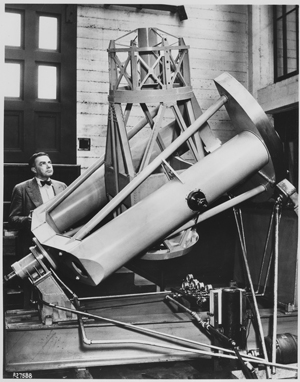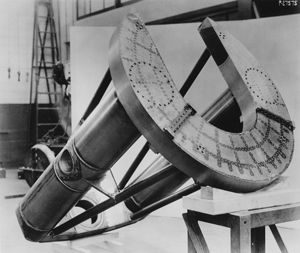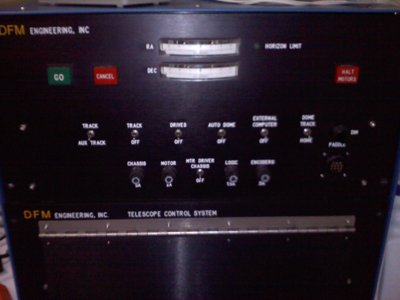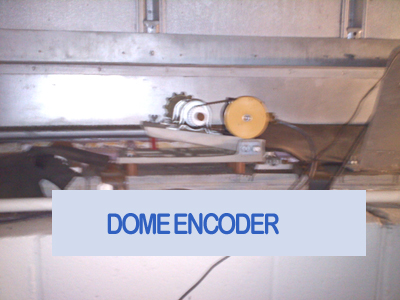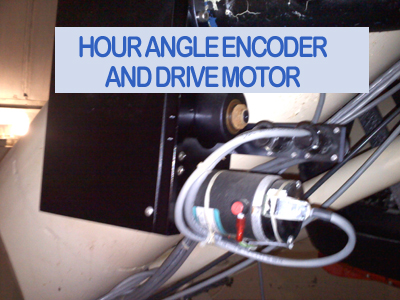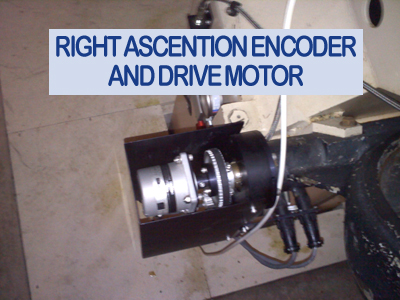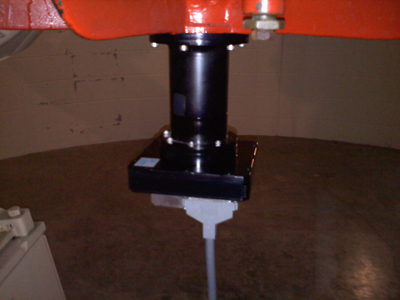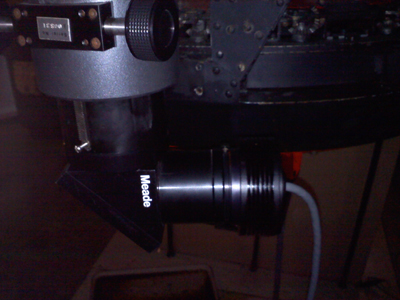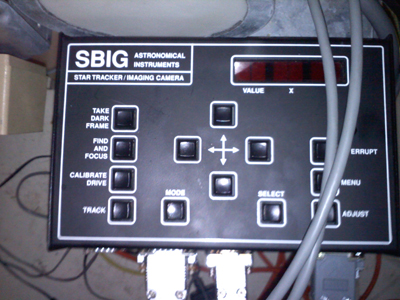User Tools
Sidebar
Table of Contents
~~TOC~~
Eileen Collins Observatory
20“ Telescope Upgrade and Repairs
My journey of learning, and exploration.
Overview
I initially started working on the 20” telescope at the Eileen Collins Observatory two semesters ago. I was a student in Observational Astronomy and became fascinated with all things space. This dovetailed perfectly with my interest in technology.
The following details the work done on the telescope to bring it to it's full useful potential.
The Telescope
The telescope has a long history. It was built in 1935 under the direction of Captain Clyde S. “Sandy” McDowell as a 1/10 scale engineering prototype for the 200“ telescope at the Palomar Observatory1).
The telescope was used for years as a training device at CalTech before it was donated back to Corning Inc. It was stored for a time at the Museum of Glass and then donated to Corning Community College. The Elmira/Corning Astronomical Society2) received funding to build the observatory that it now resides in.
As a prototype, the telescope was identical to the 200” telescope in most every detail, but it was never intended to be used for actual observing. The mirror was an unfigured piece of glass without proper mounting, the control systems were obsolete. The mirror was eventually configured properly, and a modern control system was installed. The telescope was in use for some time, one observer cataloged over 20 newly discovered asteroids.
When I took the class, I became interested in the telescope and was curious about it's operation. It turns out that it was not in service due to mechanical problems, the main problem being the dome would not track the telescope and would continually rotate. Simple, I thought….
Control System
Before I go into the details of the repairs and upgrades, I want to give an overview of how the control system works.
The telescopes primary control is through a DFM Engineering TCS system. The TCS handles input from the telescopes position encoders, and output to it's drive motors. It controls the telescopes tracking rate, focus routines, steering to targets, and dome tracking.
Target selection and coordinate input is handled through a program called TheSky. TheSky is ran on a secondary computer that communicates to the TCS via a COMM connection using the ACL (Astronomical Command Language) protocol. Target imaging is also handled through this computer via an array of programs such as MaximDL and WXAstrocapture.
Position input from the telescope and dome are tracked using three encoders located on the right ascention and hour angle of the telescope, and one connected to the dome. The encoders provide relative feedback to TCS which interprets position from the equipments start-up location. The position information can be synced through TCS and TheSky if there is location error at startup, which is often the case.
The Curious Case of the Ever Turning Dome
The first problem that I encountered was that when dome tracking was turned on, and the telescope position was change, the dome would start rotation, but not stop. It would continue to rotate as long as power was still supplied to it. I obtained a copy of the observatory schematics and narrowed it down to the dome encoder system.
The first part of the process of elimination was to check the security of all connections. When all of the connections appeared to be in good order, the wires to the encoder were ohmed out, they turned out to be fine as well. It was at this point we had someone tell us that they could have the encoder checked for proper function, we sent the encoder out and found out that it was bad and placed a new one on order. After arrival and installation of the new encoder hopes were high - turns out that we were in store for a let down, the dome continued to operate as it did before.
I then placed a call to DFM who directed me to a few more places to look for the problem. When a signal is returned from the encoder to the TCS motherboard, it must first be processed by an encoder receiver chip. This chip digitizes the analog signal and provides the positioning information that TCS requires to track the system. On the TCS motherboard, there are three chips that perform the same operation, one for the right ascension, one for the hour angle, and one for the dome position.
I swapped the hour angle chip with the dome position chip, started up the system, and drove the telescope on it's right ascension axis. The dome began to move, and stopped exactly where it should. Looking at the TCS control interface, the hour angle position was jumping erratically, confirming my suspicion that the chip was the culprit. A little research found that the chip was not in production anymore, though a replacement was available for the optimum price of ninety-nine cents, I ordered two.
Replacing the bad chip with the new cured the problem.
System Upgrades
Main Camera
Searching around the supply room, I was confronted with a box, upon opening I was surprised to see a high end Apogee AP-7 astronomical camera sitting there with all of its cables. Up to this point, we were using a Meade DSI II camera for imaging. The Meade is in the price range of 300-400 dollars, and though a respectable camera for a backyard observer, it was in no way up to the caliber of the now properly working 20“ telescope.
As it turns out, the Apogee camera was put in storage after the original interface board malfunctioned. Apogee did not make the old ISA boards anymore and could not provide a replacement. I began to research and found out that they did produce a PCI board at one point that would fit our more modern imaging computer. I made a few posts on the astronomical user groups and within a day received a response. Turns out a gentleman in Poland (yes, Poland the country) had a board from a slightly newer camera that would possibly work. I contacted Apogee directly and found out it would require new firmware, and they just happened to have the last PROM with it burned onto it. They shipped it to me for 8 dollars. Not bad!
After receiving both the board and the new firmware, I installed it into the imaging computer, hooked up the camera, and fired up MaximDL. The camera worked flawlessly. We were now able to take long exposure images… up to a point. Turns out there is a problem when exposing more than 40 seconds or so. The guide rate of the telescope is not perfect and starts to cause trails appear in the star images. There is also a periodic error from the mechanical gearing of the telescope that distorts the stars. Bummer! Being that I was now obsessed with making everything work correctly, I searched for a solution, and that solution was called auto-guiding.
Auto Guiding
Another jaunt through the mysterious supply room found another box, inside it was two cameras and their controllers. One was a Sbig ST-6 camera with a color filter wheel, and the other was a smaller camera, labeled ST-4. I did some research and found that the ST-4 was the grand-daddy of all autoguiders. An autoguider camera mounts to a secondary telescope mounted to the main system. It locks on to a star in its field of view and sends control signals to the telescope to keep it dead center on the target. This blows away unguided tracking as it updates continually and eliminates periodic error as well.
The ST-4 camera connects to an interface box that can be connected to a secondary computer for remote control via serial link, or used stand alone. There was already a serial cable ran to the control room from the telescope, so this should be easy right? Wrong!
The imaging computer only had one serial port, and that was being used to connect to the TCS computer. Attempts for communication were made using a USB/Serial converter, but they failed miserably. I went out and purchased a new serial card and installed it.
Amazingly enough, it was able to communicate. The learning curve on operating the autoguider was pretty steep, but in the end we managed to figure it out. The telescope now has the ability to lock onto a star, and steer the telescope. The previous limitation for exposure time of less than a minute was increased to however long the object was in the telescopes limits. For a test, I took a 40 minute exposure of the Andromeda galaxy, and the stars in the field of view were pin pricks - perfectly guided.
Future Upgrades
There are a number of upgrades that I would like to have done to make this a truly research worthy telescope. Firstly an automated color filter system. We have been able to obtain some amazing images, but the addition of color would make a world of difference. I have actually started a project build from scrap computer parts that I plan on finishing in the future that could work as a basis for a larger system.
I also plan on modifying the TCS software to allow external focus control. There is software out there that will take a series of images and adjust the focus to be as optimal as possible. For me, focusing is the most frustrating aspect of an enjoyable hobby.


